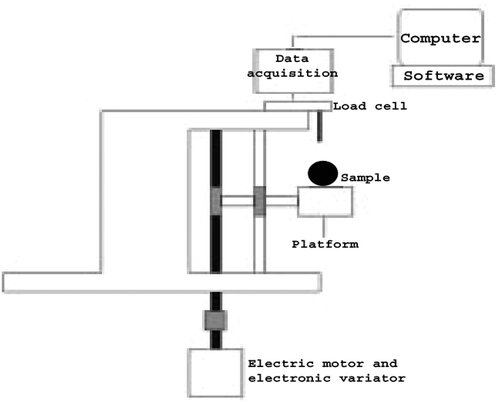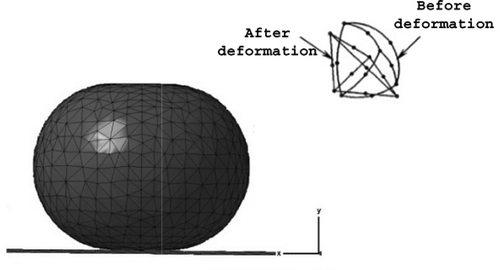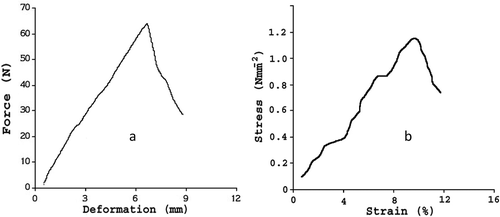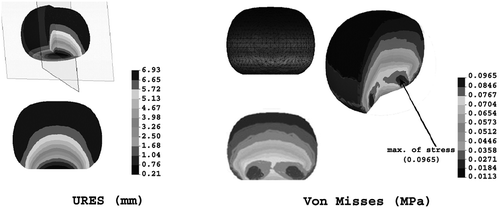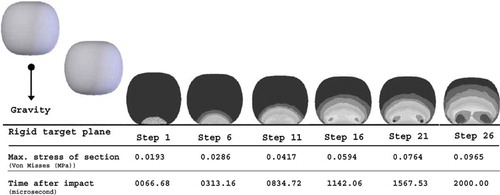Abstract
It is very important to determine mechanical damage quantity of fruit and vegetables during harvesting, handling, transportation, and storage. Specifically, determining damage quantity of agricultural products is very difficult on existing external forces. However, one of the useful methods is the finite elements method that can be used in different engineering disciplines to simulate the behavior of materials under the defined boundary conditions. In this study, a drop-test simulation was performed for peach samples by means of finite elements method. Some mechanical properties of the sample were measured by an experimental study (compressive test) and the obtained data were used in the finite elements method simulation. The stress-strain and force-deformation curve of peaches were determined as maximum force, Poisson’s ratio, specific deformation, modulus of elasticity, stress, and deformation energy were found to be: 59.6 N, 0.29, 10.9%, 0.89 Nmm–2, 1.19 Nmm–2, and 162.2 Nmm, respectively. At the end, the distribution of stress and shape of deformation of sample peaches at impact was obtained. When the stress magnitudes were evaluated, simulation outputs showed that simulation stress values are quite a bit compatible with experimental data.
INTRODUCTION
Fruit and vegetables are an important component of the human diet and consumers usually expect such products to have premium quality. Texture is a major quality attribute which influences consumer acceptance, shelf life, resistance, and transportability. Mechanical property data of plants and plant products are critical information for the design of agricultural machine or automation equipment. Without a database of basic and mechanical characteristics, engineers must design plant handling and processing equipment using empirical methods that increase the development time and the costs. Thus, mechanical properties of agricultural materials have been a major thrust for many researchers. Also, the quality of fruits and vegetables can be determined by their external and internal characteristics. The most important external characteristics are the size, shape, smell, appearance, and product presentation, while the most important internal characteristics are the taste and texture.[Citation1,Citation2]
Although it is difficult to determine such properties of biological materials, some methods and approaches are used in literature. Obtained mechanical properties of biological material are used in order to determine the deformation quantity of biological materials in mechanized agricultural production. Due to the structure of the biological cell structure of fruits and vegetables, deformation behavior is imponderable exactly for them. Today’s developing technologies and computers allow for numerical methods to be used to simulate the behavior of material under defined boundary condition. Today, analytical methods for stress analysis are available only for a few simple cases, so their applications are limited. The practical cases occurring in agricultural engineering mostly represent complex problems, which may be solved only by numerical methods.[Citation3] In addition, these methods allow us to evaluate stress values, strain energy, and displacement on damaging area of biological materials as an approach. One of these approaches is to estimate the stress field of biological materials using the finite elements method (FEM).[Citation4] The FEM is a numerical procedure currently applied for many engineering problems, whose complex formulation does not allow exact solutions. This technique combines a series of mathematical concepts to produce systems of linear and non-linear equations, whose solution is based on computational techniques. It has been used in the analysis of mechanical stress in various agricultural products, thus allowing the modeling of irregular geometrical objects.[Citation5]
Many reports are available in the scientific literature on finite element (FE) modal analysis and resonant frequencies of various kinds of near spherical agricultural objects such as apples, peaches, melons, and tomatoes.[Citation6–Citation10] These researches showed that FE model analysis is a suitable method for calculating the resonance properties of near-spherical solid materials.
Peaches are much more susceptible to mechanical damage due to their soft texture. However, few studies have been done on the damage of peaches. Only a few studies were done on the drop test for peaches using FE method simulation, and hence, the need for this study. In the simulation, a sample peach was dropped from its minimum damage height. Simulation results showed the occurrence of stress distribution in the initial section of the peach and the deformation behavior of peaches body under the defined drop cases.
MATERIAL AND METHODS
Material
Peaches were chosen as a sample of agricultural material in this study. One hundred samples were used in the experimental study in order to measure their mechanical properties. Samples were obtained from the local market of Antalya in Turkey during the 2013 peach harvest season, and kept in storage at about 0°C and 90% relative humidity, until laboratory analyses were performed. Samples were randomly selected from the local market. During laboratory tests, all analyses were carried out at room temperature of 20–21°C.[Citation11] The tests were conducted within the Biological Test Devices Laboratory of Akdeniz University, Antalya, Turkiye and INMA, National Institute of Research-Development for Machines and Installations Designed to Agriculture and Food Industry, Bucharest, Romania.[Citation11]
Determination of the Physical Properties of Peaches
The physical properties of peach fruit were determined by the following methods: Linear dimensions, i.e., length (L), width (W), and thickness (T) were measured using a vernier caliper with a sensitivity of 0.01 mm. Fruit mass (M) was measured using an electronic balance with a sensitivity of 0.001 g. Fruit density was determined using the liquid displacement method. Toluene (C7H8) was used instead of water, as it is absorbed by fruits to a lesser extent. Also, its surface tension is low, so that it fills even shallow dips in a fruit and its dissolution power is low.
Determination of the Mechanical Properties of Peaches
To determine the mechanical properties of peaches in compressive tests, a biological material test device was used with a force measurement range of 0–100 N and the measurement accuracy was 0.001 N and 0.0015 m (). A curve-ended cylindrical probe with diameter of 8 mm was used to compress the fruits at 7 mm/min–1 loading velocity during all tests.[Citation12] Compression force was applied to the middle of the material in three repetitions for each sample. From the compression speed and time, fruit deformation was computed.
After measuring the initial length and width of the fruit, compression was applied until deformation occurred on the fruit’s body. Poisson’s ratio (λ) of the fruit was calculated using the following formula and by measuring the final diameter and length after deformation;[Citation13]
When a halved section of fruit is compressed with a spherical indenter (), where E is the apparent modulus of elasticity in Nmm–2, F is the applied compressive force in N, λ is Poisson’s ratio (dimensionless), D is the deformation under compression in mm, Ku is the constant for the upper convex surface (1.3514), Ru is the minimum radius of curvature of the sample at the point of contact in mm, R’u is the maximum radius of curvature in mm, and d is the diameter of curvature of the spherical indenter in mm. Deformation energy (Ed) was determined directly from the chart by measuring the area under the force-deformation curves.
Drop-Test Simulation
In this study, the aim was to investigate the deformation behavior of a biomaterial on crash. In order to do this, a three-dimensional (3D) drop-test simulation has been generated for a sample peach using finite element analysis (FEA). Drop-test studies interested with the effect of the impact of a part or an assembly with a rigid or flexible planar surface. Dropping an object on the floor is a typical application, and hence, the name. In the study, Cosmosworks FEA commercial software was used for the drop-test simulation of a peach. This software calculates the impact and gravity loads automatically. No other loads or restraints are used. The software calculates the velocity (V) at impact from V = (2.g.h)1/2, where, g is gravity [ms–2], h is drop height [m]. The body moves in the direction of gravity as a rigid body until it hits the rigid plane (no rotations are considered until the initial impact occurs). The software solves a dynamic problem as a function of time.[Citation15] To account the damage height for peach equation of “h = [(3/2)5.σ.ε.R3]/m.g” was used,[Citation16] where, h is damaging height, mm; σ is average stress, N/mm2; ε is elongation percentage; R is the radius of curvature, mm; m is mass, kg; g is gravity, ms–2.
RESULTS AND DISCUSSION
The results obtained from the determined physical properties of peach used in the experiment are shown in .
Table 1 Physical properties of peach
The results of compression test, the stress-strain, and force-deformation curve of peach were determined as maximum force, Poisson’s ratio, specific deformation, modulus of elasticity, stress, and deformation energy were found to be 59.6 N, 0.29, 10.9%, 0.89 Nmm–2, 1.19 Nmm–2, and 162.2 Nmm, respectively. When comparing the simulation results with physical test, it was observed that the results were in agreement with the arguments presented by Zohrabi et al.[Citation17] The determined mechanical parameters of peaches were used by the drop test of FE analysis.
After a compression study, a drop-test simulation has been generated for a peach and its behavior was observed while being dropped from 263.6 mm high under the gravity of Earth according to the peach’s compressive test data. The peach solid body deformed so far as maximum 6.93 mm and maximum stress occurred on the inner structure of the peach as 0.0965 MPa on step 26 when the values and the observed deformation behaviors, it can be seen that values of simulation are quite bit overlapped with stress values from compressive test data that had given stress-strain and force-deformation exchange ().
Table 2 Some of the mechanical properties of peach
Table 3 Drop test parameters
In the study, a sample peach has been modeled as 3D solid by Solidworks 3D parametric design software. Assumptions were made that a peach is nearly spherical, solid, and its skin has the same properties within the entire body. All dimensions (average of dimension data from compression test data of biomaterials), rigid target plane, and peaches solid model are shown in .
To generate drop-test simulation, the Cosmosworks FEA software drop-test module has been used. In the simulation, a second order (high order) solid tetrahedral element was used for the mesh construction of a peach fruit 3D model. The total nodes being 32,542 and the total elements numbering 22,671 have been obtained after the meshing operation (). In the drop-test simulation, Von Misses Plasticity Material Model has been assumed for the biomaterial. To get material model properties for the peach compression test, data have been evaluated for 20 samples of peaches. Some of mechanical properties can be seen in and the stress-strain and force-deformation curve simulation is presented in .
Instructions were given to the software to calculate a default observation time interval from 3L/Ve, where L is the largest model box size and Ve is the speed of the elastic wave in the material. Ve is calculated as the square root of the ratio modulus of elasticity/density. The software internally calculates appropriate time increments that can be non-uniform. In the simulation, drop-test parameters have been set up as following values as shown in . After completed settings for drop-test parameters analysis solve process has been run. The results of the solve process, step of 26 Von Misses stress, and deformation values results are shown in . Additionally, sample steps are shown respectively with section Von Misses stress values of sample steps and the Von Misses stress evaluated by FEM simulation at a loading condition in .[Citation15,Citation19,Citation20] The same results were found in this study when the result of FEM simulation was compared with the study of deformation behavior simulation of a sample apple under the impact effect with FEM by Celik et. al.[Citation21,Citation22]
CONCLUSION
In the engineering area, many problems can be solved by using analytical methods. But complex problems cannot be solved with just the same ease. To obtain solutions of complex and imponderable problems, we must do some assuming, and numerical methods can be used to obtain the approximation of a problem’s solution. The aim of this study was to determine the deformation behavior of a sample peach under the gravity impact effect using a numerical method. In this article, an experimental study was generated to obtain some mechanical properties of peaches, and then the deformation behavior of the peach was simulated by FEM using experimental data. As shown in this study, FE simulation gives a well prescience to unknown, complex, or hard to estimate problems in engineering. Consequently, computer aided simulations can help to determine the behavior of biomaterials on mechanical damage during harvesting, handing, transportation, and storage cases.
FUNDING
This study was partly supported by the Scientific Research Fund of Akdeniz University, Antalya, Turkey and INMA, National Institute of Research-Development for Machines and Installations Designed to Agriculture and Food Industry, 70 Bucharest, Romania.
Additional information
Funding
REFERENCES
- Abbott, J.A.; Bachman, G.S.; Childers, N.F.; Fiztgerald, J.V.; Matusik, F.J. Sonic Techniques for Measuring Texture of Fruit and Vegetables. Food Technology 1968, 22, 635–645.
- Wang, J.; Sheng, K.C. Variations in Firmness and Sugar Content in “Huanghua” Pear (Pyrus Pyrifolia “Nakai”). Journal of Horticultural Science and Biotechnology 2005, 80 (3), 307–312.
- Sitkei, G. Mechanics of Agricultural Materials; Elsevier Science Publisher: Budapest, Hungary, 1986.
- Cardenas, W.M.; Stroshine, R.L. Melon Material Properties and Finite Element Analysis of Melon Compression with Application to Robot Gripping. Trans of ASAE 1991, 34 (3), 920–929.
- Gunay, D. Muhendisler Için Sonlu Elemanlar Metodunun Temelleri (Basic of Finite Element Methods for Engineer); Sakarya University Publish: Sakarya, Turkey, No: 003, Turkish Translation From B. Nath, 1993.
- Chen, H.; De Baerdemaeker, J. Finite-Element-Based Modal Analysis of Fruit Firmness. Trans of ASAE 1993, 36 (6), 1827–1833.
- Lu, R.; Abbott, J.A. Finite Element Modeling of Transient Responses of Apples to Impulse Excitation. Trans of ASAE 1997, 40 (2), 1395–1406.
- Verstreken, E.; De Baerdemaeker, J. Evolution of Maturity of Peaches: Non-Destructive Firmness Measurement from the Acoustic Impulse Response. International Agrophysics 1994, 8, 469–473.
- Chen, H.; De Baerdemaeker, J.; Bellon, V. Finite Element Study of the Melon for Nondestructive Sensing of Firmness. Trans of ASAE 1996, 39 (3), 1057–1065.
- Langenakens, J.; Vandewalle, X.; De Baerdemaeker, J. Influence of Global Shape and Internal Structure of Tomatoes on the Resonant Frequency. Journal of Agricultural Engineering Research 1997, 66 (1), 41–49.
- Asae Standard. Moisture Measurement Grains and Seeds; Agricultural Engineers Years Book. American Society of Agricultural Engineers: St Joseph, MI, 1982.
- Asae Standard. Compression Test of Food Materials of Convex Shape in; ASAE Standards 452, American Society of Agricultural Engineers: St Joseph, MI, 1993.
- Mohsenin, N.N. Physical Properties of Plant and Animal Materials; Gordon and Breach Science Publisher: New York, NY, 1980.
- Braga, G.C.; Couto, S.M.; Hara, T.; Neto, J.T.P. Mechanical Behaviour of Macadamia Nut under Compression Loading. Journal of Agricultural Engineering Research 1999, 72, 239–245.
- Cosmosworks Professional. Training Manuel. Doc Number: PMT0086-ENG, Solidworks Corp., USA, 2006.
- Horsfield, B.C.; Fridley, R.B.; Claypool, L.L. Application of Theory of Elasticity to the Design of Fruit Harvesting and Handling Equipment for Minimum Bruising. Trans of ASAE 1972, 15 (4), 746–750.
- Zohrabi, S.; Seiiedlou, S.; Alipasandi, A. Study Some Physical and Mechanical Properties of Three Cultivars of Peach in Maturation Stages. World of Sciences Journal 2013, 4, 108–117.
- Kabas, O.; Celik, H.K.; Ozmerzi, A.; Akinci, I. Drop Test Simulation of a Sample Tomato with Finite Element Method. Journal of the Science of Food and Agriculture 2008, 88, 1537–1541.
- Walter, D. Formulars for Stress, Strain, and Structural Matrices; John Wiley and Sons Inc.: Michigan, 1994.
- Kim, G.W.; Kim, M.S.; Sagara, Y.; Bae, Y.; Lee, I.-B.; Do, G.S.; Lee, S.H.; Kang, S. Determination of the Viscoelastic Properties of Apple Flesh under Quasi-Static Compression Based on Finite Element Method Optimization. Food Science and Technology Research 2008, 14, 221–231.
- Celik, H.K.; Kabas, O.; Topakci, M.; Ozmerzi, A.; Akinci, I. Deformation Behavior Simulation of a Sample Apple under the Impact Effect with Finite Elements Method, 10th International Congress on Mechanization and Energy in Agriculture, Oct 14–17, 2008; Antalya, Türkiye, 893–897.
- Khodabakhshian, R.; Emadi, B. Development of a Finite Element Method Model to Determine Mechanical Behavior of Pumpkin Seed. International Journal of Food Properties 2015, 18, 231–240.

